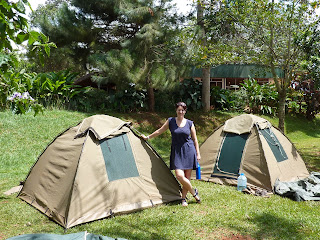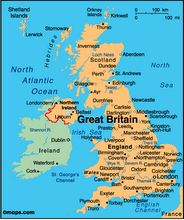 Day 12: Travel to Lake Nakuru, Kenya
Day 12: Travel to Lake Nakuru, KenyaIt was another early start on Wednesday, as we departed Jinja and returned to Kenya. We were up at 4.40am and left the camping ground at 6am. We crossed the border from Uganda into Kenya in the morning and continued driving east towards Lake Nakuru.
We stopped for lunch at around 1pm at a shopping centre in a decent sized town (at about 2000m altitude), apparently home to many of Kenya's famous long distance runners! The supermarket at the shopping centre was pretty good - we found a fridge magnet there and also stocked up on water and snacks.
We drove for another three hours after lunch. We had some music playing in the truck, which made the trip more enjoyable. We passed a few villages that looked relatively prosperous - the people were well dressed, there were children in proper school uniforms and there were lots of market stalls selling fresh fruit and veges. We could not get over how green parts of Kenya are - such lush and fertile farmland, pretty hills and mountains - almost New Zealand-like. Most of Uganda and parts of Kenya (at high altitude) get a lot of rain, which is great for the farmland but bad for our leaky tents!
We arrived at our camp site at Lake Nakuru at around 6pm, set up our soggy tents and had a few drinks in the bar. Tim played a bit of table tennis with Andrew, which turned out to be a surprisingly skillful game. Dinner was delicious again - and we ate it sitting around an open camp fire.
Day 13: Lake Nakuru game drive
We had the luxury of a "sleep-in" today...until 6.10am. We also had a cooked breakfast and hot showers, so it was a great start to the day. We left the camp site at 7.45am and made the short drive to Nakuru town. It was a public holiday in Kenya, so not much was open. We had a leisurely walk through town and checked out a few shops. Tim found a barber and got his hair cut - quite an experience! We got mobbed by street vendors when we tried to get back on the truck, so we bought some postcards, a Kenyan head scarf and some cold drinks off them.
We then drove into the Lake Nakuru National Park. Lake Nakuru is one of the Rift Valley soda lakes, which lies about 100km north-west of Nairobi. The lake's abundance of algae attracts vast quantities of flamingos - apparently more than one million flamingos inhabit the National Park! The park is also famous for its pelicans and other birds, as well as black and white rhino.
There were literally hundreds of birds huddled on the edge of the lake, although not so many flamingos for some reason. We're not sure where you hide a million flamingos, but we only saw a couple of dozen of them all day! We did, however, see hundreds of pelicans, storks and many other birds! We saw plenty of gazelles and impala, zebras, waterbucks, giraffes (these were Rothschild's giraffes, which are a different subspecies from the Masai giraffes), buffaloes and...wait for it...rhinos!!!
At first we saw a few rhinos off in the distance, which didn't make for great photos. Then later in the afternoon we got a magnificent view of a rhino close up on the side of the road. All of the rhinos we saw were of the white rhino subspecies, which can be distinguished from the much rarer black rhino by its square upper lip and a hump on the back of its neck. The white rhino is not actually white at all - it is grey. As you can see from the photo below, they are massive animals, measuring 3.5 - 4.5 metres in length, weighing up to 4 tonnes and usually sporting a huge horn on their noses. The rhino sighting completed our Big Five game viewing, which was very exciting!
We left the game park and drove for 1.5 hours south-east to Lake Naivasha, arriving at our camping ground just after dark and in drizzly rain. We had a nice dinner of beef stew and pasta and then had a couple of quiets in the bar.
Day 14: Lake Naivasha
Friday was a lazy day at the campsite at Lake Naivasha. There were some optional activities available, which some of our group did - a bike ride around the lake to see some birds or a short hike to see some birds. We opted to stay at the camp, so we had a sleep in and a late breakfast at 8am - delicious french toast and banana.
It was a scorching hot morning, so we dried out the tent and did some washing. It was very peaceful around the camp, aside from an aggressive turkey, who spent the morning chasing a female turkey around the lawn and hissing and gobbling at us. Quite amusing. We watched the third/fourth playoff of the Rugby World Cup, on the TV in the bar. We wanted Wales to win, but they played badly and Australia won a disappointing game 21-18.
After lunch, there was a spot of rain, but it cleared up quickly. We had a couple of drinks in the bar, played some pool, and tried to have a game of back yard cricket - but the resident campsite dogs were very sharp in the field, grabbing the ball at every opportunity and not relinquishing it without a fight. We really enjoyed hanging out with our group - we were very lucky to have such a quality group.
Dinner was steak, potatoes and salad. Our tour leader, Mwangi, tried to get us to go a "nightclub" next to the camping ground, but it wasn't getting started until after 11pm (way past our African bedtime), so we bailed and went to bed. A few of the guys went along and said it was lame - hardly anyone else there.
Day 15: Nairobi
On Saturday morning, we had a short drive from Lake Naivasha to Nairobi. We left at 7.45am and arrived in the capital at 9.30am. We dropped off three of our group who were leaving the tour at that stage - it was a bit sad to see them go, but on the up side, Tim inherited a head torch from Max, who no longer needed it. We then drove to our campsite and dropped off our gear before heading to an elephant orphanage.
The elephant orphanage was amazing. They look after baby elephants who are literally orphaned, or who get lost and cannot find their family, or who get trapped, fall down holes, etc. Then they raise them at the orphanage until they are old enough to be released back into the wild. We had a talk from the staff of the orphanage, explaining what the elephants eat and drink, the activities they do at the orphanage and stories of where some of the elephants had come from.
We then watched the elephants roll around in the mud, kick a soccer ball around and drink milk from large plastic bottles. Interestingly, they feed the elephants human baby formula imported from the UK, as they obviously do not have access to elephant milk and they cannot use cow or goat milk etc, as the elephants are badly allergic to it and it will kill them. The orphanage also houses a black rhino, which is almost completely blind, meaning it could not survive in the wild. It was nice to see a black rhino for the first time (black rhinos are extremely rare) but we felt very sorry for it.
Next stop was a giraffe centre, where we had the opportunity to feed some of the giraffes. The giraffe centre backs on to the Nairobi Nature Park, where animals can roam relatively freely in a large enclosed park. When the giraffes want to, they can wander over to the giraffe centre to be fed or just hang out with some humans!
We went up on to a raised platform and fed some animal pellets to two of the giraffes, a very young one and a 16 year old giraffe called Laura, who proved to be a hit with one of our tour group, Sara. While the rest of us fed Laura pellets from our hands (giraffe tongues are very rough and scratchy), Sara stuck a pellet in between her teeth and Laura ate it from there, effectively giving Sara a big kiss and covering her face with giraffe slobber - photo below. It was very cool to see giraffes so close up - they really are the most elegant of all the animals.
After a brief visit to a large shopping centre, we headed back to camp and chilled out at the bar for a couple of hours. In the evening, a group of us went to a restaurant called "Carnivore" - needless to say, it was a meat restaurant! It was an amazing place - all you can eat meat for a set price, and it was all types of meat. We had beef, lamb, pork, chicken, turkey, crocodile, ostrich, different types of sausages and even ox testicles! We ate so much we could barely move. Tim had stomach cramps all night - but it was worth it.
At such a brilliant place as Carnivore, you need a strategy. Tim and Dean had it all sorted. You don't go near the soup, bread, potato or veges. These are all tricks - just fillers. Once you steer clear of those, you can focus on the meat. Also, you need to pace yourself - there's no hurry at Carnivore. So there you go, when you go to Carnivore, you have a few tips from the experts.

Tim at the
barber

Lake
Nakuru -
birds

Our
truck

Pelicans
and
flamingos

Flamingos

Us at Lake
Nakuru

White
rhinos

Elegance

Awesome
white
rhino

Lake
Nakuru
camp

Elephant
orphanage

Elephant
baby
drinking

Neens and
Megs

Elephant
soccer

Black
rhino

Laura -
elegant

A giraffe
kiss for
Sara

Megs
feeding
giraffe

Carni-
vore

Lake
Nakuru


































